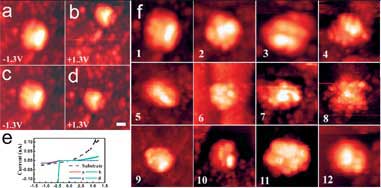| Posted: May 18, 2007 |
CAS reports progress in developing nanotechnology data storage |
|
(Nanowerk News) New advancements have been scored by Chinese Academy of Sciences (CAS) scientists on ultrahigh-density information storage as they successfully carried out the reversible, erasable and rewritable nanorecording on H2 thin films of rotaxane, a superamolecular structure of dumbbell-like molecules trapped within the cavity of macrocycles. According to a recent issue of Journal of the American Chemical Society (JACS), the feat by far gives the most direct evidence for the nanorecording behaviors caused by conductance transition in rotaxane molecules, which indicates a promising future for molecular memories after necessary chemical modifications.
|
 |
| Reversible conductance transitions induced sequentially in an individual rotaxane molecule by the STM field. (Image: CAS)
|
|
With great potential to be used as the building blocks for molecular electronics and nanotechnology data-storage media, rotaxane molecules can undergo reversible structural transition followed by conductance switching in solution. However, the conductance switching stayed ambiguous in solid-state form. By 2005, CAS nanoscientists from the Institute of Physics (IoP) and the Institute of Chemistry (IoC) had jointly reported the writing of high-conductance nanoscale marks on rotaxane H1 thin films. However, the erasing part showed some difficulties.
|
|
Based upon this work, the collaborators further improved the structure of rotaxane molecules. Their late JACS report demonstrated high stability of some nanodots written with ~3nm feature size in the air at room temperature. According to the reviewer of the paper, it "provides convincing evidence that the data-reserving dots are able to be rewritten, erased and recovered on an improved H2 rotaxane thin film¡The most amazing part is a minor change in the core structure of rotaxane molecules can bring enormously impacts upon its functional behaviors." The research also found an introduction in the highlight column of Nature Nanotechnology under the title of "Nanorecording: rewriting history."
|
|
The research team also observed the structural and conductance transitions of a single rotaxane molecule at a submolecular scale. With the help of low-temperature scanning tunneling microscopy (SPM), they discovered that the conductance switching of the rotaxane molecule results from its inherent property, in other words, an intramolecular structural transition of the molecule itself. The full paper was published in the fifth issue of Advanced Functional Materials (AFM).
|
|
The development of functional materials featuring stability, rewritability and reversibility has already become a hot topic in ultrahigh-density data storage research. At CAS, interdisciplinary nanoscientists have joined hands in this regard ten years ago. The IoP research team led by Prof. GAO Hongjun was mainly responsible for the preparation of experimental equipment such as thin films and SPM, as well as the related theoretical computation and analysis, while the IoC workgroup head by Researchers SONG Yanlin and ZHANG Deqing carried out the design and synthesis of the molecules. Targeting at a refined control over the structure and physical properties of function-material molecules, they have reaped a series of progresses, among which seven of their academic papers were published by the JACS, AFM and Nature.
|

